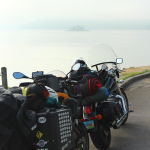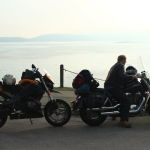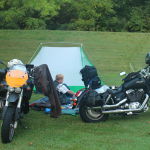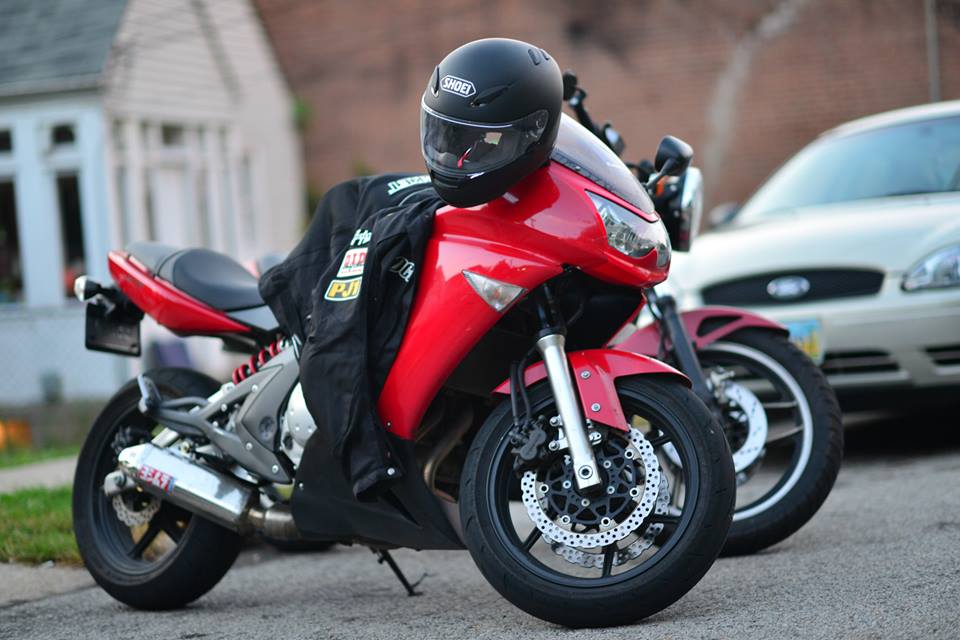First Rung of the Ladder:
Black Beauty
Black Beauty wasn’t actually her name, but she was definitely female.
A co-worker had mentioned it earlier. ‘Not a penny less than $3900’. He handed me the flyer, a crude picture with a few specs. My father was a motorcyclist in his earlier years; my main inspiration. Storing his non-running 1972 CB350 in the garage for many years made for a convenient source of imagination while growing up.
I had done plenty of research. Constructed in Maysville, Ohio, she was as ‘American’ as any Harley-Davidson. 2001, one-thousand and ninety-nine cubic centimeters, two wheels, two cylinders, black paint and chrome accents. With about 50 horsepower more than she would have liked, Mom received three pictures. The following morning, I drove to my co-worker’s house, 39 Franklins in my pocket. After a short time at the BMV, Ken (my co-worker selling the motorcycle) followed me home, riding my new purchase conveniently to my parent’s garage. She was parked, shiny, and eager. I was eager.
There was only one problem: I had no idea how to ride a motorcycle.
After recieving my Motorcycle Temps, I quickly scoured the internet, and came across my tutorial of choice. Mordeth13, an ‘E-famous’ internet motorcycle vlogger, taught me the ways of motorcycle. His video, “How to Ride a Motorcycle for the Very First Time!” was one of the first and only videos I needed to learn the ways of my dinosaur-exploding-two-wheeled-freedom-machine. I started practicing in the garage, slipping the clutch just enough to move the bike forward a few inches, then stop. A few feet, then stop. Roll her back, a few more feet, then stop. The entire first evening was spent in the garage.
Driving a manual car for a long time definitely helped, but this was a new world. On a motorcycle, each limb has a different responsibility: Your right hand controls throttle and (front) brake. Left hand, clutch. Right foot controls rear brake, the left shifts gears. Not only are you driving a manual-car upside down, you have to steer as well. But WAIT! Steering only works the way you think it does at very low speeds. Anything faster than a than a crawl, the steering dynamic changes to what is coined Countersteer. In lame-Mayan terms: its opposite while rolling. On top of that, you are not held on or in by any means. There is no safety cage.
Now for the good news.
My parents had rightfully chose to raise us on a safe, small neighborhood with a cul-de-sac. Aside from massive snow piles in the winter (fun in the Jeep!) and gravel in the summer, this was the perfect place to learn, just seconds from her cozy garage. I rode back and forth, around and around this cul-de-sac just like I had growing up on a bicycle. Anything other than the sewing-machine-silent exhaust would have drove (rode?) the neighbors crazy.
A few days experience, I began to venture out onto the streets nearby. Quiet, little traffic, and mainly stop-sign intersections. This was fantastic for learning the first (of two) most difficult things for inexperienced riders: Learning how to go and stop. It is important to get the clutch fully engaged in a smooth and quick manner. Motorcycles have a lot of centrifugal forces in the wheels and crank, creating a very stable gyroscopic effect at speed. Confident with this experience, it was time to tackle the next most difficult thing.
Countersteer, and the Ohio Motorcycle Skills Test
I knew I wanted my full Motorcycle Permit. In Ohio, there are several limitations having only a temporary permit: You are required to wear a helmet (and for one full year after receiving your full MC-license), no passengers, no riding at night, and no interstate highways. Not that any of these were necessarily limiting, especially for an inexperienced rider, but I just had to pass the full test.
Exploring streets for a few days, we found ourselves at the nearest BMV Motorcycle testing facility. I researched the exercises they were going to test. Painted lines on the asphalt with an idea of the exercises necessary, I practiced for several days. Confidence rose, cone weaving was defeated, countersteer had triumphed. As with many people, wrestling my 600-pound motorcycle through the cones was the most difficult part. Wide cruiser-handlebars helped with leverage, maintaining speed helped with balance, and practice helped solidify my intentions.
We were ready
Purchased on a Thursday, temporary permit and first ride on a Friday, skills test the following Friday. I wasn’t good, and I wasn’t experienced, but this endorsement was now a personal Everest. I showed up one last time, the night before, and practiced with another new rider taking their test tomorrow as well. Another hour of parking-lot stops, goes, turns and weaves. We arrived early, met with a large group ready for their tests as well. Confidence was peaked, I was one of the first to test.
It was nothing short of perfect. No deductions, no drops, stalls, or foot-downs. Ecstatic and elated, I rushed out of the BMV with my freshly-printed License, the small ‘MC’ designation on the reverse my newest stamp of accomplishment. We weren’t seen at home for days.
Looking back, I still don’t think the skills test was that difficult. It covers basic control of your motorcycle, everything a new or low-experienced rider should learn, while boosting my confidence to learn my capabilities. If you are having trouble with your skills, practice and practice. You are never finished, but practice until these are second-nature, until your ferrous steed is an extension of your reactions and wit. You will need it.
-Rob
This Honda Shadow was sold a couple years ago to make way for my Ulysses, and is now owned by a good friend Lugnut, an active member of the CMA.
From our 2013 Mountain Adventure Trip
- Bikes loaded
- Douglas Lake, TN
- Lots of morning dew







